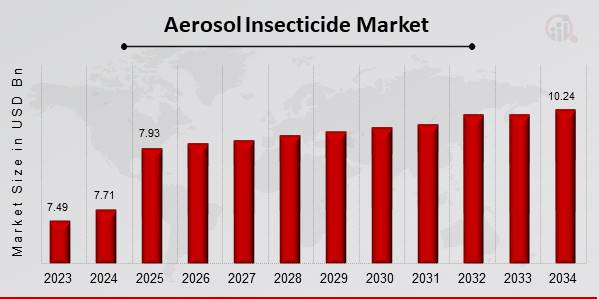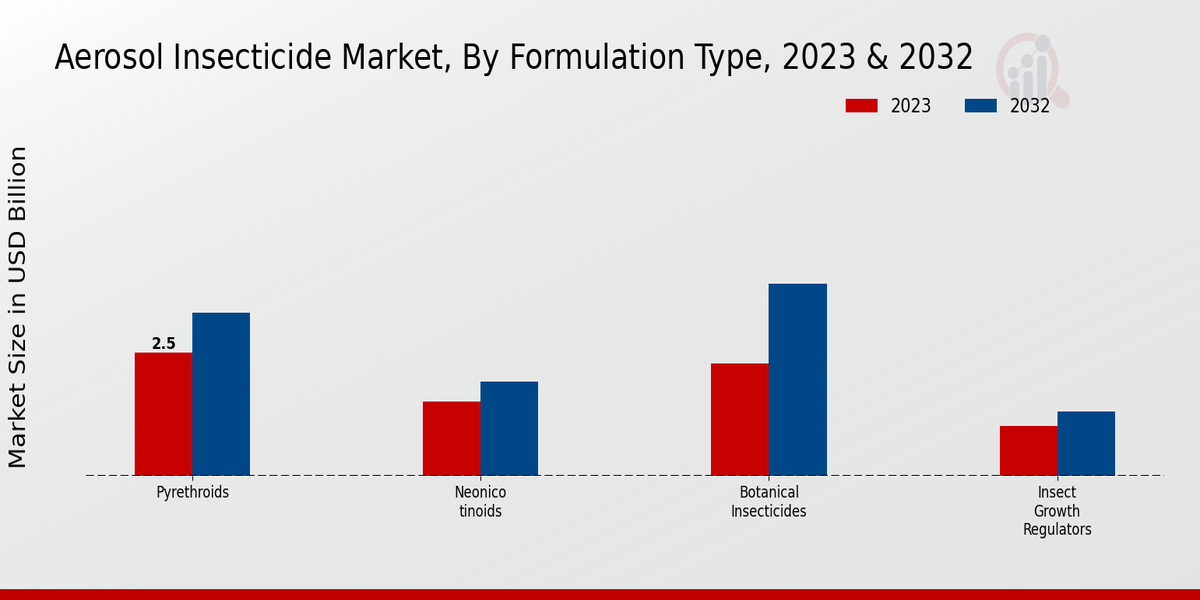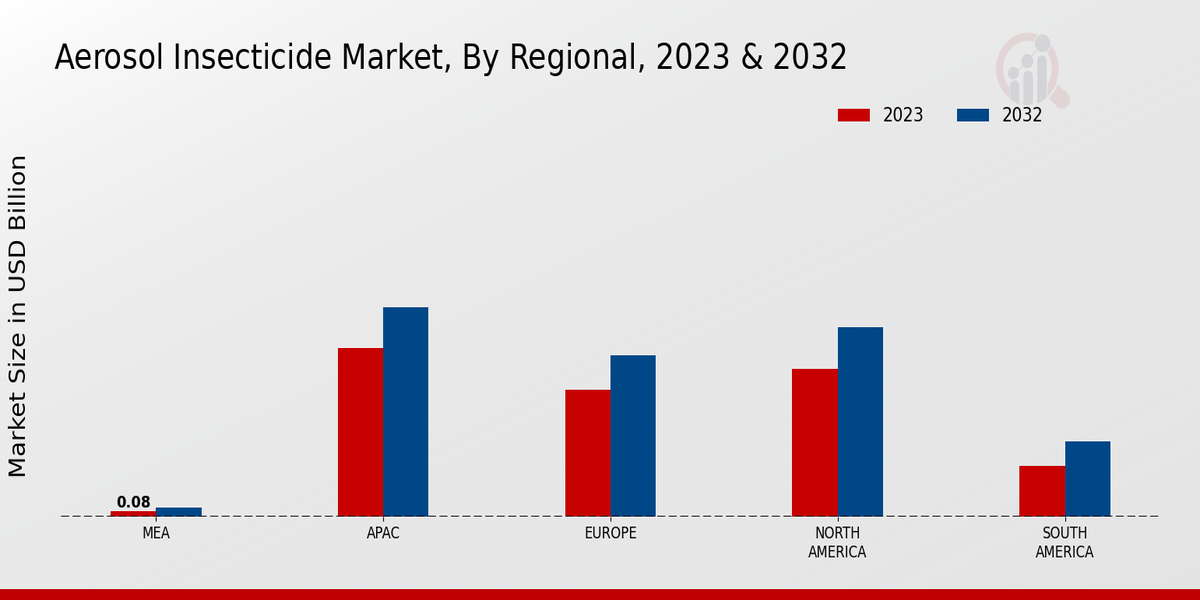Global Aerosol Insecticide Market Overview
Aerosol Insecticide Market Size was estimated at 7.71 (USD Billion) in 2024.The Aerosol Insecticide Market Industry is expected to grow from 7.93 (USD Billion) in 2025 to 10.24 (USD Billion) by 2034. The Aerosol Insecticide Market CAGR (growth rate) is expected to be around 2.9% during the forecast period (2025 - 2034).

Source: Primary Research, Secondary Research, MRFR Database and Analyst Review
Key Aerosol Insecticide Market Trends Highlighted
The Aerosol Insecticide Market is currently being driven by a surge in urbanization and changing lifestyle patterns, which has led to a higher incidence of pest-related issues in residential and commercial spaces. Increased awareness regarding the health hazards posed by pests is prompting consumers to invest in effective insect control solutions. Moreover, developments in technology are enhancing the formulation of aerosol insecticides, making them more effective and user-friendly. As consumers seek convenience and efficiency in pest control, manufacturers are focusing on product innovation, leading to a heightened demand for eco-friendly and low-toxicity formulations. Opportunities within this market are abundant, especially in emerging economies where urban expansion and rising disposable incomes are creating an increased demand for pest control products. Companies can explore the potential of natural and organic insecticides to cater to the growing segment of health-conscious consumers seeking safer alternatives. Furthermore, the expansion of e-commerce platforms provides a new channel for reaching a broader audience, allowing companies to capitalize on changing consumer purchasing behaviors. Recent trends indicate a shift towards sustainability and environmental responsibility, with consumers favoring brands that emphasize eco-friendly practices in manufacturing and packaging. The rise of smart home technologies also presents opportunities for integration with automated pest control systems, aligning with the digitalization trend in household management. As consumers become more educated about the benefits of advanced pest management solutions, the demand for innovative aerosol insecticides continues to evolve, presenting both challenges and prospects for industry growth.
Aerosol Insecticide Market Drivers
Increasing Urbanization and Population Growth
The Aerosol Insecticide Market Industry is significantly driven by the rapid pace of urbanization and population growth observed in various regions. As more people move to urban areas, the density of living spaces increases, leading to a rise in pest populations that thrive in close quarters. This surge in pest presence heightens the demand for effective pest control solutions, including aerosol insecticides. Urban environments often provide a rich habitat for insects such as mosquitoes, cockroaches, and flies, which can create public health concerns due to the diseases they may carry.Moreover, the increased propensity for outdoor recreational activities, coupled with the need for food safety and hygiene, further propels the demand for aerosol insecticides. Households and businesses alike are seeking convenient and effective means to manage pest populations, driving the adoption of aerosol formulations. The compact and easy-to-use nature of aerosol products provides a practical solution for consumers looking to maintain pest-free environments in their homes and workplaces, contributing to the overall growth of the Aerosol Insecticide Market Industry.As urban areas continue to expand, the ongoing need for pest management solutions will remain a critical driver of the market.
Rising Awareness of Health and Hygiene
In recent years, there has been a growing focus on health and hygiene, especially in the wake of public health challenges. The Aerosol Insecticide Market Industry is benefiting from increased consumer awareness regarding the importance of keeping living and working spaces free from pests that can carry diseases. As individuals become more informed about the health risks associated with insect exposure, they are turning to aerosol insecticides as effective preventive measures.This shift in consumer behavior is likely to drive market growth as more households and businesses prioritize sanitary environments.
Innovation in Product Formulations
The ongoing innovation in aerosol insecticide formulations is another significant driver for the Aerosol Insecticide Market Industry. Companies are continuously investing in research and development to create more effective, environmentally friendly, and user-friendly products. This includes advancements in the efficacy of active ingredients, as well as the development of non-toxic and biodegradable formulations. Such innovations not only cater to the evolving preferences of environmentally-conscious consumers but also enhance the competitive landscape of the industry, further fueling market growth.
Aerosol Insecticide Market Segment Insights
Aerosol Insecticide Market Formulation Type Insights
The Aerosol Insecticide Market, which is expected to reach a value of 7.28 USD Billion in 2023, showcases diverse formulation types, significantly impacting market dynamics. Among these formulations, Pyrethroids stand out with a valuation of 2.5 USD Billion in 2023, growing to 3.3 USD Billion by 2032, marking it as a dominant segment due to their efficacy and widespread usage in agricultural and domestic pest control. Neonicotinoids, while being relatively smaller, hold an important position with a valuation of 1.5 USD Billion in 2023, rising to 1.9 USD Billion in 2032, characterized by their unique neurotoxic mechanism, which is crucial for targeted pest management.On the other hand, Botanical Insecticides exhibit a significant presence, valued at 2.28 USD Billion in 2023, expanding to 3.9 USD Billion by 2032. This growth is propelled by increasing consumer preferences for natural and organic products, reflecting a shift towards eco-friendly pest control solutions. Insect Growth Regulators represent a niche yet valuable aspect of the market, estimated at 1.0 USD Billion in 2023 and anticipated to rise to 1.3 USD Billion by 2032, focusing on altering insect development processes to prevent future infestations.The notable growth trends across these formulation types highlight varying consumer needs and regulatory influences, showcasing opportunities for innovation and expansion in the Aerosol Insecticide Market. The intersection of environmental concerns and pest control efficiency illustrates the complexity and potential of this market segment. The market dynamics are influenced by evolving regulatory landscapes, increasing awareness of pest management solutions, and a growing inclination towards sustainable practices, propelling advancements in formulation technologies across all types.As manufacturers optimize their offerings to align with market trends, the Aerosol Insecticide Market segmentation presents a clear picture of the growth prospects and challenges ahead.

Source: Primary Research, Secondary Research, MRFR Database and Analyst Review
Aerosol Insecticide Market Application Method Insights
The Aerosol Insecticide Market is projected to be valued at 7.28 USD Billion in 2023, showing steady growth driven by various application methods. Indoor Applications significantly contribute to the market, as they address pest issues within residential and commercial spaces, leading to increased demand. Outdoor Applications cater to landscaping and gardening needs, essential for maintaining aesthetic and functional outdoor environments. Agricultural Applications play a crucial role in pest control for crops, directly impacting food security and agricultural productivity.Public Health Applications are vital for controlling disease vectors, making them highly significant in urban settings and rural areas alike, especially in regions prone to vector-borne diseases. As the market continues to evolve, understanding the Aerosol Insecticide Market segmentation allows stakeholders to identify trends, growth drivers, and challenges, ensuring better alignment with consumer needs and effective resource allocation in a competitive landscape. Market growth is further supported by innovations in formulation and delivery systems, which enhance efficacy and sustainability across various application methods.
Aerosol Insecticide Market Target Insect Type Insights
The Target Insect Type segment of the Aerosol Insecticide Market plays a crucial role in determining the overall dynamics and preferences of consumers. In 2023, the market was valued at 7.28 USD Billion, reflecting the growing demand for effective pest control solutions. Among various types, flying insects and crawling insects represent significant segments due to their common occurrences in residential and commercial spaces. The importance of stored product pests in this market cannot be overlooked as they directly impact food safety and supply chains, driving the need for effective insecticides.Termites, being notorious for their destructive nature, also dominate the market due to increasing incidences of termite infestations in buildings, thus elevating the demand for targeted treatments. The increasing urbanization and changing lifestyle patterns further underscore the necessity for aerosol-based solutions, leading to enhanced market growth. Factors such as the growing awareness of health and hygiene, along with technological advancements in product formulations, are fueling the expansion of the Aerosol Insecticide Market revenue and statistics related to this segment.
Aerosol Insecticide Market End-User Segment Insights
In 2023, the Aerosol Insecticide Market is valued at 7.28 USD Billion, showcasing a steady interest in various end-user applications. The segmentation of this market highlights significant categories such as Residential, Commercial, Agricultural, and Industrial uses, each playing a pivotal role in overall consumption. The Residential segment has always been prominent due to the increasing concerns over household pest infestation, reflecting a major consumer demand for aerosol insecticides. The Agricultural segment remains vital as pest control is crucial for maintaining crop yields, thus supporting food security.Commercial applications dominate the market as businesses prioritize pest management to ensure hygienic environments, particularly in the hospitality and healthcare sectors. Industrial use, while smaller, is essential for maintaining sanitary conditions in manufacturing and production facilities. Collectively, these segments fuel the growth and innovation of the market, propelling its expansion in response to changing consumer needs and regulatory pressures aimed at sustainable practices in pest control. The Aerosol Insecticide Market data illustrates the ongoing trends, challenges, and opportunities across these end-user categories, highlighting the importance of strategic investments to capture emerging market dynamics.
Aerosol Insecticide Market Packaging Type Insights
The Aerosol Insecticide Market revenue is shaped significantly by its Packaging Type segment, which encompasses various forms such as aerosol cans, trigger sprays, pump sprays, and refill packs. In 2023, the market is valued at 7.28 USD Billion, with packaging types contributing to its growth through convenience and consumer preference. Aerosol cans dominate this segment due to their ease of use and ability to deliver precise doses, appealing to a broad range of consumers. Trigger sprays are becoming increasingly popular, driven by their user-friendly features and versatility in applying insecticides effectively in various areas.Additionally, pump sprays are appreciated for their eco-friendly design and refillable options, providing sustainable choices for consumers. Refill packs have also garnered attention, aligning with the growing trend towards sustainability and cost-effectiveness. Overall, these packaging variations are pivotal in addressing consumer needs and driving market growth within the Aerosol Insecticide Market industry. Market trends highlight the importance of convenience and environmental consciousness, presenting opportunities for further innovation in packaging solutions as the demand continues to evolve.
Aerosol Insecticide Market Regional Insights
The Aerosol Insecticide Market revenue is shaped by various regional dynamics, with North America leading the market at a valuation of 2.15 USD Billion in 2023, followed closely by Asia Pacific at 2.45 USD Billion and Europe at 1.85 USD Billion. The significant presence of established brands and innovative products in North America contributes to its majority holding in the market. Asia Pacific's growing population and urbanization foster a rising demand for effective pest control solutions, reflected in its strong market performance. Europe also maintains a robust market presence due to increasing health and safety concerns regarding insect-borne diseases.Following these regions, South America and the Middle East and Africa show lower valuations at 0.75 USD Billion and 0.08 USD Billion respectively, but they present opportunities for growth driven by increasing awareness of pest-related health risks and improved distribution channels. The continuous evolution of consumer preferences and the need for innovation in formulation and packaging are crucial growth drivers, which are in alignment with market trends. Collectively, these elements shape the Aerosol Insecticide Market statistics, presenting a dynamic landscape for stakeholders.

Source: Primary Research, Secondary Research, MRFR Database and Analyst Review
Aerosol Insecticide Market Key Players and Competitive Insights
The Aerosol Insecticide Market is a dynamic and rapidly evolving sector characterized by intense competition among various key players. This market includes a wide range of products designed to control insects and pests effectively, catering to both residential and commercial applications. Competitors in this landscape are continuously innovating to develop more efficient and environmentally friendly formulations while addressing regulatory challenges concerning safety and ecological impact. Competitive insights reveal a landscape where factors such as pricing strategies, product differentiation, brand loyalty, and distribution channels play a crucial role in determining market share. Furthermore, the growing awareness of public health issues related to pest infestations creates opportunities for companies that can offer effective solutions, while also navigating the complexities of compliance with environmental regulations and customer preferences.BASF SE holds a prominent position within the Aerosol Insecticide Market, benefiting from its extensive research and development capabilities. The company's strength lies in its commitment to innovation, enabling it to introduce advanced formulations that align with market demands for efficacy and sustainability. BASF SE leverages its presence to reach diverse customer segments and maintain a competitive edge in various regions. The firm also places a strong emphasis on sustainability, developing products that meet environmental standards without sacrificing performance. This strategic focus on both innovation and sustainability enhances BASF SE’s reputation, making it a trusted choice among consumers seeking effective aerosol insecticides. The combination of a robust product portfolio and a commitment to meeting evolving market needs positions BASF SE as a formidable competitor in this industry.Woodstream Corporation is another key player in the Aerosol Insecticide Market, known for its focus on consumer-driven products. The strength of Woodstream Corporation lies in its ability to offer a diverse selection of effective insect management solutions that cater to the everyday needs of consumers. By prioritizing product effectiveness coupled with user-friendliness, the company has built a strong brand presence, appealing to both residential customers and professional pest control operators. Woodstream Corporation's innovative marketing strategies also enhance its visibility in the market, allowing it to capture consumer interest through engaging outreach and a strong online presence. Its responsive approach to customer feedback and market trends enables Woodstream Corporation to adapt swiftly, maintaining relevance and competitiveness in the ever-evolving landscape of aerosol insecticides. Overall, the company's commitment to quality and innovation solidifies its standing in the competitive market environment.
Key Companies in the Aerosol Insecticide Market Include
- BASF SE
- Woodstream Corporation
- Reckitt Benckiser Group
- Spectrum Brands Holdings
- Terminix Global Holdings
- Henkel AG KGaA
- Nufarm Limited
- Bayer AG
- Unicharm Corporation
- Ecolab Inc.
- SC Johnson Professional
- ProcterGamble
- Amro, Inc.
- C. JohnsonSon, Inc.
- Godrej Consumer Products Limited
Aerosol Insecticide Market Industry Developments
Recent developments in the Aerosol Insecticide Market have highlighted significant trends and innovations, driven by rising concerns over vector-borne diseases and environmental sustainability. The ongoing regulatory changes are impacting product formulations, as manufacturers increasingly seek eco-friendly and biodegradable options to appeal to environmentally conscious consumers. Innovations in aerosol technology have enhanced product efficacy and application convenience, prompting a surge in demand across both residential and commercial sectors. Additionally, geopolitical factors and supply chain disruptions are influencing pricing and availability, as highlighted by recent industry reports. Partnerships between companies and research institutions are fostering advancements in pest control solutions, aligning with public health initiatives. As the market anticipates a valuation of USD 9.4 billion by 2032, the focus on safety and environmental impact continues to shape product development and consumer preferences, reflecting a broader awareness of health and ecological considerations in pest management strategies. players are also actively exploring new markets and distribution channels to capitalize on growth opportunities as they adapt to evolving consumer needs and regulatory landscapes.
Aerosol Insecticide Market Segmentation Insights
-
Aerosol Insecticide Market Formulation Type Outlook
- Pyrethroids
- Neonicotinoids
- Insect Growth Regulators
- Botanical Insecticides
-
Aerosol Insecticide Market Application Method Outlook
- Indoor Applications
- Outdoor Applications
- Agricultural Applications
- Public Health Applications
-
Aerosol Insecticide Market Target Insect Type Outlook
- Flying Insects
- Crawlings Insects
- Stored Product Pests
- Termites
-
Aerosol Insecticide Market End-User Segment Outlook
- Residential
- Commercial
- Agricultural
- Industrial
-
Aerosol Insecticide Market Packaging Type Outlook
- Aerosol Cans
- Trigger Sprays
- Pump Sprays
- Refill Packs
| Report Attribute/Metric |
Details |
| Market Size 2024 |
7.71 (USD Billion) |
| Market Size 2025 |
7.93 (USD Billion) |
| Market Size 2034 |
10.24 (USD Billion) |
| Compound Annual Growth Rate (CAGR) |
2.9% (2025 - 2034) |
| Report Coverage |
Revenue Forecast, Competitive Landscape, Growth Factors, and Trends |
| Base Year |
2023 |
| Market Forecast Period |
2025 - 2034 |
| Historical Data |
2019 - 2023 |
| Market Forecast Units |
USD Billion |
| Key Companies Profiled |
BASF SE, Woodstream Corporation, Reckitt Benckiser Group, Spectrum Brands Holdings, Terminix Global Holdings, Henkel AG Co. KGaA, Nufarm Limited, Bayer AG, Unicharm Corporation, Ecolab Inc., SC Johnson Professional, Procter Gamble, Amro, Inc., S. C. Johnson Son, Inc., Godrej Consumer Products Limited |
| Segments Covered |
Formulation Type, Application Method, Target Insect Type, End-User Segment, Packaging Type, Regional |
| Key Market Opportunities |
· Natural and ecofriendly formulations · Expanding urban population growth · Increased vector borne disease prevalence · Innovative packaging and dispensing technologies · Rising demand for outdoor pest control |
| Key Market Dynamics |
Increasing urbanization, Growing health concerns, Regulatory pressures, Rising pest resistance, & Expanding agricultural practices |
| Countries Covered |
North America, Europe, APAC, South America, MEA |
Frequently Asked Questions (FAQ) :
The Aerosol Insecticide Market is expected to be valued at 10.24 USD Billion in 2034.
The expected CAGR for the Aerosol Insecticide Market from 2025 to 2034 is 2.9%.
North America is projected to have the largest market size, valued at 10.24 USD Billion in 2034.
The Pyrethroids segment is expected to be valued at 3.3 USD Billion by 2032.
The Neonicotinoids market segment is expected to grow to 1.9 USD Billion by 2032.
BASF SE is one of the major players in the Aerosol Insecticide Market.
The Botanical Insecticides segment is expected to reach 3.9 USD Billion in 2032.
The Insect Growth Regulators segment is projected to be valued at 1.3 USD Billion in 2032.
The South America region is expected to have a market value of 1.1 USD Billion in 2032.

















